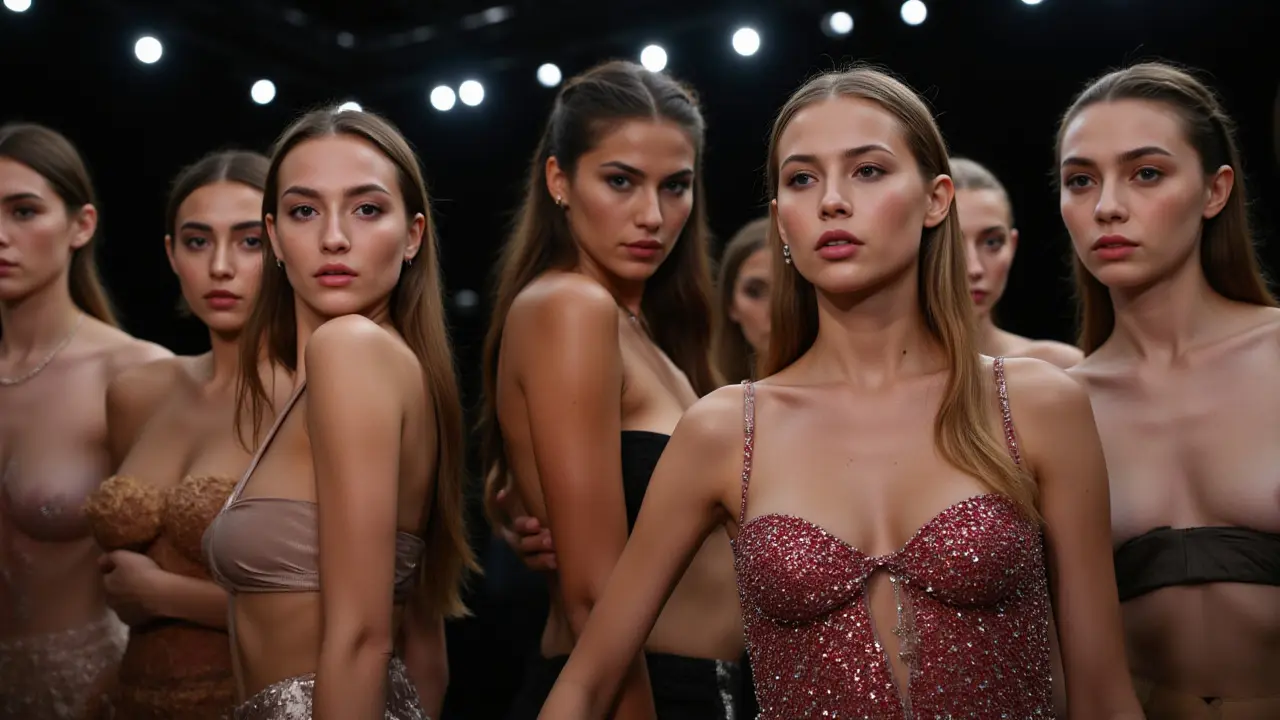All those magazine covers and drool-worthy Instagram posts can fool anyone into thinking modeling is nothing but fame, travel, and designer freebies. But don’t buy that glossy filter just yet. Hidden behind the bright lights, being a model means handling some real challenges that most people never see. Actually, the cons of being a model can take a toll not only on your wallet, but also on your mind and body. I’m not saying there aren’t perks (and I’ll admit I love seeing Delilah’s reaction when I score a cool project), but before anyone chases modeling dreams, they should see the full picture—no Photoshop.
The Pressure Cooker: Mental, Physical, and Social Strain in Modeling
This business puts you smack in the middle of the world’s harshest beauty contest, every single day. There’s no getting around it—models are constantly judged, compared, and even rejected based on their look. Agencies and clients usually want very specific faces, bodies, even personalities. And those standards shift faster than fashion trends. A Paris agency might favor doll-like faces one month and then want edgier, androgynous looks the next. The stress is real: a study from Model Alliance showed that more than 60% of working models have experienced anxiety related to body image and job security. That’s not just nerves—it’s ongoing, and it can mess with your mental health.
The pressure to stay thin leads a lot of people straight into unhealthy behaviors. Ever heard of the "sample size" nightmare? That means clothes are made for models with 23–24 inch waists, which is way below average. In one survey (2019, British Fashion Council), almost half the models admitted to skipping meals before castings. It’s no surprise that eating disorders run rampant in this job. And then there’s the physical exhaustion. You might think photo shoots are all about lounging around and looking pretty, but often, it’s hours and hours of uncomfortable poses, makeup touch-ups, freezing weather, and aching feet in sky-high heels. Don’t expect a comfy 9-to-5, either—the hours can be brutal and unpredictable, and jobs sometimes come with almost zero notice.
Socially, this line of work can feel pretty lonely. You’re on the move constantly. One week you’re in Milan, the next you’re stuck in a dingy hotel room in Paris, missing birthdays and family stuff. The competition can make it tough to form real friendships with other models, because let’s face it—everyone’s gunning for the same jobs. If you’re not careful, you can end up isolated, living out of a suitcase, with only your phone for company.
| Con | Percentage of Models Affected | Source |
|---|---|---|
| Anxiety/Stress | 60% | Model Alliance Survey, 2022 |
| Eating Disorders | 40% | British Fashion Council, 2019 |
| Loneliness/Isolation | 55% | Model Health Report, 2020 |
| Job Insecurity | 72% | Fashion Workwatch, 2021 |
Ever wonder why some supermodels quit in their 20s? Mental health is a big reason. When you’re young, it’s easy to brush off the stress, but after a while, it adds up. Even the most successful models talk openly about burning out, crashing diets, and feeling chewed up by the system. Sure, the runway lights look great—but no amount of likes or magazine tearsheets can fix feeling empty.

The Business of Modeling: Money Myths and Harsh Realities
Here’s a hard pill to swallow: Most models do not make much money. Forget the headlines about paydays in the millions—those are the Gisele Bündchens and Kendall Jenners of the world, and that’s a tiny slice. The majority hustle for much less, and sometimes get paid in “exposure” (read: nothing). In New York, beginner models can earn as low as $30 an hour for photoshoots, or even less for online catalog work, while agencies take up to 20% commission off every job. There are stories of models waiting months to get paid, or worse, getting stiffed by shady clients altogether.
It doesn’t stop with low pay. Expenses can eat up your wallet lightning-fast. Agencies will often “advance” you for travel, comp cards, or test shoots, but these are really loans you have to pay back…out of your future jobs. Some models finish busy seasons owing agencies money instead of making a profit. If that’s not enough, there’s no union or real job security, so when times get slow (looking at you, pandemic), there’s no safety net. Models also rarely get health insurance or retirement plans through agencies. You have to be your own accountant, HR rep, and manager—all while looking flawless on camera.
This is a gig economy like no other. There’s fierce competition from all over the globe, and every casting call feels like a lottery. According to a 2024 report from Models.com, for every 500 submissions, only 1-3 models land regular gigs with top agencies. That means rejection isn’t an occasional thing—it’s your daily companion. Every time you get a job, there’s a hundred faces behind you who didn’t. That gets draining after a while, even if you’re thick-skinned.
Don’t ignore the hidden costs either. To stay in demand, you need to invest in gym memberships, skin and haircare, wardrobe basics, and sometimes even cosmetic tweaks. Social media management is almost a prerequisite, too. If you want brands to notice you, they’re checking your Instagram, not just your portfolio. That’s a lot to juggle for a shot at being the new face of a campaign. And let’s talk scams: there are plenty of shady “agencies” and photographers who prey on new faces, promising fame but really just looking for a quick buck…or worse. If you’re not careful, you can get hurt or taken advantage of.
Quick tips if you plan to enter the game:
- Don’t ever pay a “signing fee” or upfront cash to an agency. Legit agencies take commission from jobs—not sign-up money.
- Read every contract like you’re a lawyer. Look for hidden fees, length of exclusivity, and your rights to images.
- Ask around before trusting anyone. Real reputation is everything in this business.
- Set aside cash for dry spells. Income in modeling is about as regular as a leap year.
The reality is, even the best photos can’t protect you from the wild west of fashion finances. Passion helps, but so does a tough skin and a reliable backup plan.

Safety, Exploitation, and Life After the Spotlight
This is where things get real grim. The cons of being a model include not just mental pressure or unstable cash flow, but sometimes even danger. Horror stories float around for a reason. Photoshoots in sketchy studios, pressure to pose nude, inappropriate behavior from photographers or stylists—these unfortunately aren’t rare. A 2023 Models Health Watch report said 28% of female models have faced uncomfortable or pressured situations on jobs. Guys aren’t immune either. And since so many gigs are freelance (no manager or big agency around), you’re often left to fend for yourself. For under-18 models, this gets even scarier, as some brands or agents push kids into very adult work environments with barely any protection.
The industry has seen some changes, with stricter codes and watch groups (Model Alliance, Fashion Model Directory) trying to clean things up. But enforcement is spotty across the globe. In a lot of places, there’s still basically no oversight. So if you’re new, you have to be twice as careful. Always bring a companion to first-time shoots and don’t be afraid to speak up or walk out if something feels off. Safety comes before any paycheck, no matter what slick line a photographer gives you.
Let’s not forget how short careers can be. Most models peak between ages 16 and 22. By the mid-20s, your phone might stop ringing, unless you’ve built a massive following or pivoted to acting or influencer gigs. The industry is obsessed with youth, and while there’s a little progress with “all ages, all bodies” campaigns (shout out to Ashley Graham for shaking things up), it’s still rare for long-term careers. The big question: What do you do after modeling? A lot of ex-models say they struggle with finding identity and steady income once the photos stop. Without a backup plan—education, a trade, or at least savings—the future can look shaky.
If you’re eyeing a modeling career, do yourself a favor and map out a realistic path. Maybe take classes in business, social media, or even acting. Build other interests, not just your image. Don’t forget to watch for your own wellbeing. It’s easy to lose yourself when everyone’s telling you who you should be. The people who last (or at least leave happy) know where the industry ends and where they begin.
